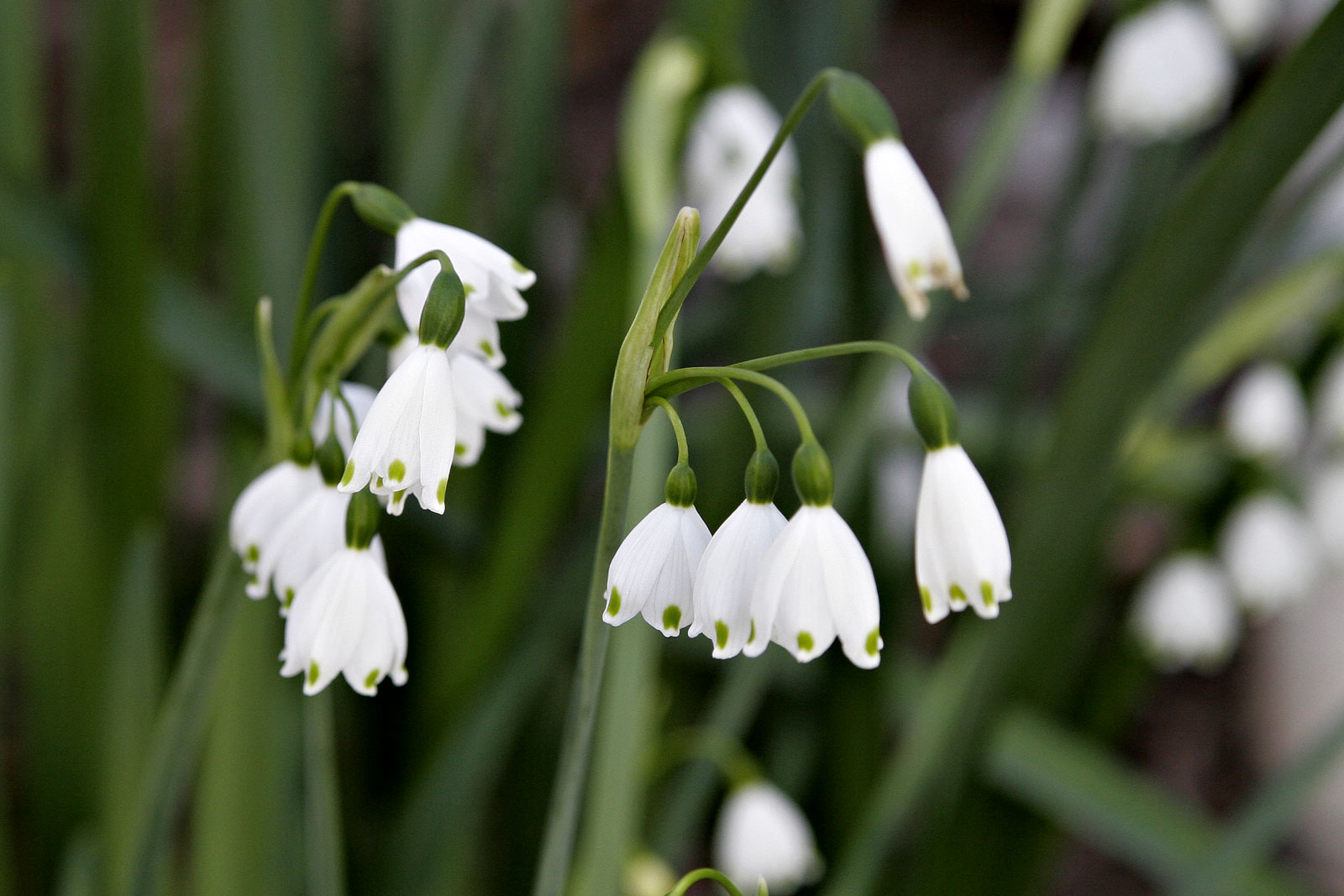- Leucojum
image_width = 250px
image_caption = Summer Snowflake ("Leucojum aestivum")
regnum =Plant ae
divisio = Magnoliophyta
classis =Liliopsida
ordo =Asparagales
familia =Amaryllidaceae
genus = "Leucojum"
genus_authority = L.
subdivision_ranks = Species
subdivision =
* "Leucojum aestivum ": ssp. "aestivum"
: ssp. "pulchellum"
* "Leucojum vernum ": var. "carpathicum"
: var. "vagneri"Spring Snowflake ("Leucojum vernum") and Summer Snowflake or Loddon Lily ("Leucojum aestivum") are bulbous plants belonging to the
Amaryllidaceae family. They are the onlyspecies currently classified in thegenus "Leucojum".Description
The snowflakes are native to southern
Europe , from thePyrenées toRomania and westernRussia , but they have been introduced and have naturalized in many other areas, including the east coast ofNorth America . They have narrow, strap-like, dark green leaves. Theflower s are small and bell-shaped, white with a green (or occasionally yellow) spot at the end of each petal. They have a slight fragrance.The Spring Snowflake normally grows 15-20 cm tall (6-8 in), though it may reach up to 35 cm (14 in). It flowers from March to May (as soon as the snow melts in its wild habitat). Two varieties of "Leucojum vernum" are known: "L. vernum" var. "carpathicum" originates from the eastern part of its natural range and is a larger plant with yellowish spots on its petals rather than green; "L. vernum" var. "vagneri" from Hungary is a robust plant, often with two flowers per stem.
The Summer Snowflake has a wider natural range, taking in Europe, southwest
Asia and northernIran , and growing in wetter habitats including damp woodland, riversides and swamps. Despite its common name it also flowers from March to May, though slightly later than the Spring Snowflake. It is a taller plant than "Leucojum vernum", growing to around 60 cm (2 ft), but its flowers are smaller and are carried in anumbel of between three and seven. Its fleshy seed pods are inflated, allowing them to be dispersed by flood water.Cultivar
"Leucojum aestivum" 'Gravetye Giant' is a selected
cultivar with larger flowers. It is named after Gravetye Manor, anElizabethan manor house inWest Sussex , England, the home of the influential garden writer William Robinson from 1884 until his death in 1935. The house is now a hotel."Acis"
Several former members of the genus, characterised by their narrow leaves, solid stems and unmarked flowers, have recently (July 2004) been reclassified as genus "Acis". Most are autumn-flowering and prefer drier soils than "Leucojum" species. "Leucojum autumnale, Leucojum nicaeense, Leucojum roseum", etc. should now be referred to as "Acis autumnalis", "Acis nicaeensis", "Acis rosea", etc.
Former species of "Leucojum" (now reclassified as "Acis")
*"Acis autumnalis " : var. "autumnalis"
: var. "oporantha"
: var. "pulchella"
*"Acis fabrei "
*"Acis longifolia "
*"Acis nicaeensis "
*"Acis rosea "
*"Acis tingitana "
*"Acis trichophylla " : var. "trichophylla"
: var. "broteroi"
: var. "micrantha"
*"Acis valentina "ee also
*
List of early spring flowers
*List of late spring flowers References
* Dolores Lledo, Aaron Davis, Manuel Crespo, Mark Chase and Michael Fay. "Phylogenetic analysis of Leucojum and Galanthus (Amaryllidaceae) based on plastid matK and nuclear ribosomal spacer (ITS) DNA sequences and morphology". "Plant Systematics and Evolution" (July 2004).
External links
* [http://www.floralimages.co.uk/leucojum.htm "Leucojum" page from John Crellin's 'Floral Images' site with many pictures and links]
* [http://www.pacificbulbsociety.org/pbswiki/index.php/Leucojum Pacific Bulb Society's "Leucojum" wiki page]
* [http://www.pacificbulbsociety.org/pbswiki/index.php/Acis Pacific Bulb Society's "Acis" wiki page]
Wikimedia Foundation. 2010.

